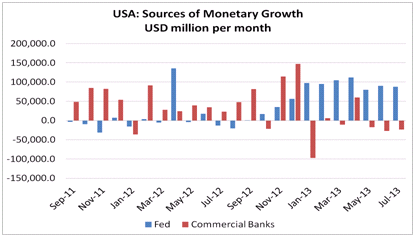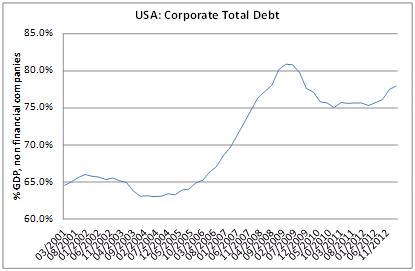Tyndall: Tapering tantrums
In the Tyndall Monthly Commentary Andrew Hunt investigates what affect the US Federal Reserve's tapering plans will have on financial markets around the word. He finds that it may create some headwinds, particularly for emerging markets and that the beneficiaries of quantitative easing have not been the people it was targeted at.
Wednesday, September 4th 2013, 12:40PM
by Andrew Hunt
Financial market participants are currently fretting over the “will they or won’t they?” question of whether the Federal Reserve will finally begin to reduce its level of asset purchases over the next few months – the so called ‘tapering policy’.
Admittedly, some analysts are maintaining that even if the Federal Reserve does begin to reduce its level of bond purchases, this will not represent a tightening of monetary policy since the banks “will still have plenty of liquidity anyway” and such a move “will not affect short term interest rates” but we have little sympathy with this viewpoint, not least of all because when the bond purchases were originally announced they were treated as an easing.
More importantly, we also find that virtually the entire current – and still reasonable – rate of monetary growth that has been occurring in the US which has presumably been supporting domestic asset prices so far this year has in fact emanated from the Federal Reserve’s continued bond purchases. Indeed, we calculate that if the Fed halves its rate of bond acquisitions, then US liquidity growth will also probably halve – or worse.
 Unbeknown to many, the US commercial banking system has essentially been shrinking its credit books – and therefore destroying liquidity – so far this year as a result of the intense if rather technical regulatory tightening that took place in early January and this is of course why the Federal Reserve has become the only de facto source of liquidity growth within the economy.
Unbeknown to many, the US commercial banking system has essentially been shrinking its credit books – and therefore destroying liquidity – so far this year as a result of the intense if rather technical regulatory tightening that took place in early January and this is of course why the Federal Reserve has become the only de facto source of liquidity growth within the economy.
Therefore, we suspect that the whole tapering question is of vital importance to the financial markets, not just in the USA but also globally.
For example, if US liquidity conditions were to tighten, then there would not only be fewer dollars within the US economy but there would also be less liquidity available globally, something which the ever cash (and credit) hungry emerging markets (EM) already seem to have been reacting to over recent weeks. After almost a decade of record levels of capital inflows (many of which were financed by the Fed and others’ quantitative easing policies), the emerging markets such as Brazil, Russia, India, China and the rest have become addicted to receiving these flows in order to fund not only their expanding public sectors but also in many cases their private consumption and investment spending growth.
However, if the capital flows on which these economies now depend were to cease or even reverse, as in many cases they already seem to be doing, then the EM will have to alter their spending patterns downwards with an obvious impact on their own growth outlook. Presumably, lower expectations for growth rates in the EM would then lead to downward revisions not only in estimates for commodity demand but also for developed world export trends.
Clearly, a seemingly esoteric ‘tapering’ by the Fed clearly has the potential to create global ramifications and in particular we suspect that even China’s newly foreign-credit-dependent economy would find life notably uncomfortable in a tapering world.
Interestingly, however, it is not entirely clear just why the US central bank would want to enact even a modest tightening at present. Following the recent slew of notably disappointing retail, personal consumption and household income data releases, and the signs that weak household income trends and rising bond yields are beginning to adversely affect the housing market, a number of prominent forecasters have begun to revise down their US growth estimates for the remainder of the year.
In fact, we have found ourselves moving into the rather unaccustomed position of being at the ‘higher end’ of growth forecasts for the US economy at present as other forecasters have leapfrogged us in a downwards direction. Certainly, the latest economic data from the US would not seem to suggest that the Fed needs to consider tightening its stance in order to combat either economic overheating or a building inflation threat.
Indeed, not just in the USA but also in much of the rest of the world inflation seems to be conspicuous by its absence. For example, in supposedly booming New Zealand (probably the fastest growing OECD economy at present), we find that despite an impressive 4% annualised rate of retail sales volume growth over the last quarter, retail prices are actually falling and headline inflation rates are essentially negligible.
The ongoing weakness in the global economy and in particular the weakness in world trade prices has ensured that many countries – the US included – are actually importing deflation at present and this too would seem to offer a solid reason for the US Federal Reserve not to tighten its stance, particularly given the instability that even a modest tapering could bring to the financial markets.
In fact, one could at this point begin to wonder just why the Federal Reserve might even be considering a tightening of its monetary policy and in fact it is our firm belief that the Fed does not actually want to tighten its policy stance, but that what it does want to do is to exit its current form of QE.
It has become increasingly obvious to those prepared to investigate the subject (a group which albeit now rather belatedly seems to include the Fed) that the main beneficiaries of QE have not been people and companies in the ‘real economies’ but rather the corporate executives, investment bankers and existing shareholders that have been predominant beneficiaries of the QE-inspired boom in corporate bond issuance around the world.
 Specifically, as the Federal Reserve and the other central banks have purchased the ‘high quality’ sovereign bonds as part of their QE policies, other investors have been obliged to move into other types of bonds and this has in turn allowed the US corporate sector to issue huge quantities of bonds of their own into these now issue-receptive markets.
Specifically, as the Federal Reserve and the other central banks have purchased the ‘high quality’ sovereign bonds as part of their QE policies, other investors have been obliged to move into other types of bonds and this has in turn allowed the US corporate sector to issue huge quantities of bonds of their own into these now issue-receptive markets.
As a consequence, we find that US corporate debt has started to return to its pre-GFC highs, a development that is clearly worrying the Federal Reserve’s more longer term focussed staffers.
If the companies had used the proceeds of their bond issues to build productive resources and create jobs, then the Fed might have been prepared to overlook this re-gearing of corporate America but instead we find that the bulk of the funds that have been raised have been used to finance equity buy-backs, high dividends and other forms of shareholder-enriching financial engineering.
It is this process, coupled with the weak wage growth in the real economy, that has led to the sharp rise in income inequality in the economy that is currently also worrying policymakers.
Consequently, we can see that the debate on whether to taper or not is not about the economy’s current cyclical position or even the outlook for inflation in the near to medium term. Instead, it is a debate between the need to support the still soft economy (and we suspect the financial markets and the EM in the near term) and the damage that the Fed’s current policy mix is exerting on the longer term financial health of the economy.
From the perspective of an outsider, it seems that the Fed’s staffers are concerned more by the latter but that the Board is more concerned by the former, a situation that makes the likely outcome of the Fed’s internal deliberations all the harder to gauge for markets.
What we can suggest however is that if the Fed does taper without finding some other hopefully less distorting way to boost US liquidity, any move towards tapering could prove to be a very significant headwind for the financial markets and it could well give rise to another ‘risk off’ moment.
Andrew Hunt International Economist London
| « A little less stimulus ahead | Hamish Douglass Unplugged - Latest Video from Adviser Briefing - August 2012 » |
Special Offers
Comments from our readers
No comments yet
Sign In to add your comment
| Printable version | Email to a friend |









